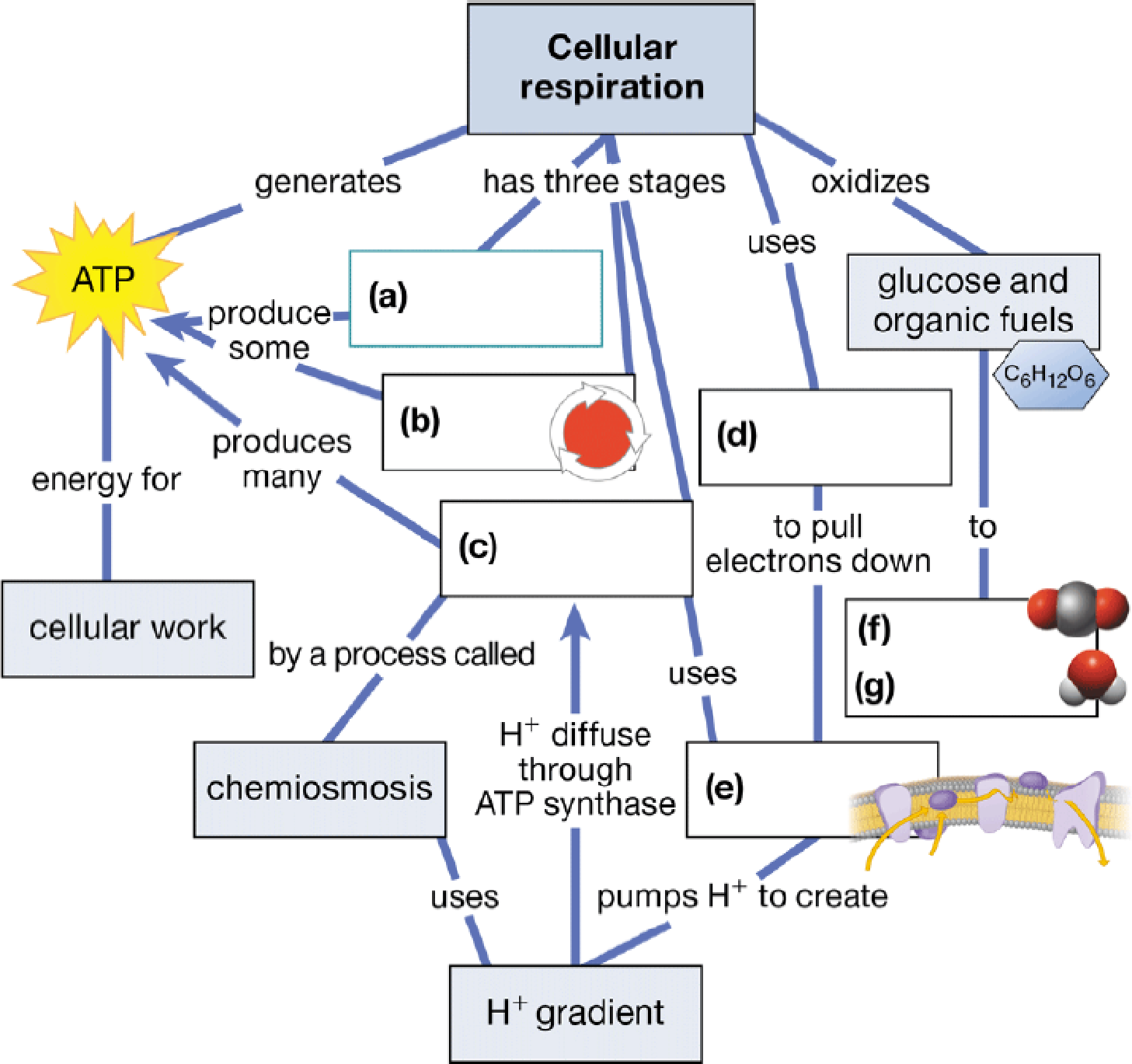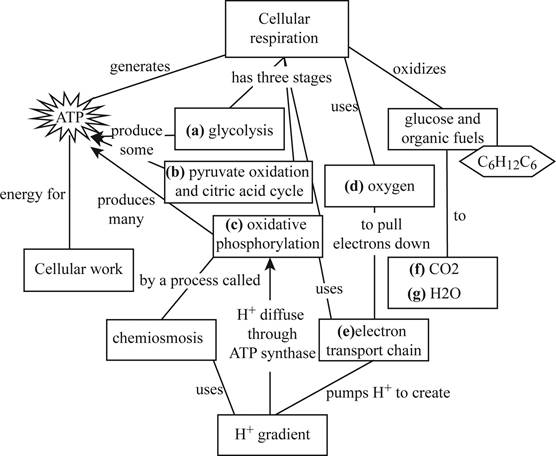
Concept explainers
Fill in the blanks in this summary map to help you review the key concepts of

To complete: The concept map to summarize the key concepts of cellular respiration.
Introduction:
The process of breathing and cellular respiration are closely associated. By breathing, an individual takes oxygen into the lungs and passes it to the blood. The blood carries the oxygen to cells where cellular respiration is carried out. Cellular respiration generates energy that is utilized for various cellular activities. There are several steps in cellular respiration; it includes glycolysis, pyruvate oxidation and citric acid cycle, and oxidative phosphorylation.
Answer to Problem 1CC
Pictorial representation: The Fig. 1 shows the vital concepts in cellular respiration.

Fig.1: Concepts map of cellular respiration.
Explanation of Solution
(a)
Correct answer: Glycolysis
Explanation:
Glycolysis is the first step of cellular respiration which occurs in the cytoplasm of the cell. The glycolysis process results in a breakdown of one glucose molecule into a three-carbon compound called pyruvate.
Hence, the correct answer is glycolysis.
(b)
Correct answer: Pyruvate oxidation and citric acid cycle
Explanation:
Pyruvate oxidation and the citric acid cycle are the second stage of the cellular respiration which takes place in the mitochondria. Here, pyruvate is oxidized into a two-carbon compound called acetyl Co-A. The citric acid cycle then completes the breakdown of glucose to carbon dioxide.
Hence, the correct answer is pyruvate oxidation and citric acid cycle.
(c)
Correct answer: Oxidative phosphorylation
Explanation:
Oxidative phosphorylation is the third stage of the cellular respiration. This involves electron transport and chemiosmosis. Oxidative phosphorylation is responsible for most of the ATP formation during the process of cellular respiration.
Hence, the correct answer is oxidative phosphorylation.
(d)
Correct answer: Oxygen
Explanation: Cellular respiration requires oxygen to trap the electrons in an electron transport chain. This helps in the generation of ATP by oxidative phosphorylation.
Hence, the correct answer is oxygen.
(e)
Correct answer: Electron transport chain
Explanation:
Electron transport chain is a series of an arranged molecular system in the mitochondrial cristae that passes the electrons to generate a proton potential across the inner mitochondrial membrane. This is required for oxidative phosphorylation and chemiosmosis.
Hence, the correct answer is electron transport chain.
(f)
Correct answer: CO2
Explanation:
Cellular respiration oxidizes the glucose and the organic fuels into carbon dioxide (CO2) and water molecules (H2O).
Hence, the correct answer is CO2.
(g)
Correct answer: H2O
Explanation:
Cellular respiration oxidizes the glucose and the organic fuels into carbon dioxide (CO2) and water molecules (H2O).
Hence, the correct answer is H2O.
Want to see more full solutions like this?
Chapter 6 Solutions
Campbell Biology: Concepts & Connections (9th Edition)
- How is a protein destined for the Endoplasmic Reticulum (ER), imported into the ER? Be concise.arrow_forwardFind out about the organisations and the movements aimed at the conservation of our natural resources. Eg Chipko movement and Greenpeace. Make a project report on such an organisation.arrow_forwardWhat are biofertilizers and mention the significancearrow_forward
- PCBs and River Otters: Otters in Washington State’s Green-Duwamish River have high levels of polychlorinated biphenyls (PCBs) in their livers. PCBs can bind to the estrogen receptors in animals and disrupt the endocrine system of these otters. The PCBs seem to increase the estrogen to androgen ratio, skewing the ratio toward too much estrogen. How would increased estrogen affect the river otter population? Based on your reading of the materials in this unit, what factors can affect fertility in humans? Explain how each of the factors affecting human fertility that you described can disrupt the human endocrine system to affect reproduction.arrow_forwardOther than oil and alcohol, are there other liquids you could compare to water (that are liquid at room temperature)? How is water unique compared to these other liquids? What follow-up experiment would you like to do, and how would you relate it to your life?arrow_forwardSelection of Traits What adaptations do scavengers have for locating and feeding on prey? What adaptations do predators have for capturing and consuming prey?arrow_forward
- Competition Between Species What natural processes limit populations from growing too large? What are some resources organisms can compete over in their natural habitat?arrow_forwardSpecies Interactions Explain how predators, prey and scavengers interact. Explain whether predators and scavengers are necessary or beneficial for an ecosystem.arrow_forwardmagine that you are conducting research on fruit type and seed dispersal. You submitted a paper to a peer-reviewed journal that addresses the factors that impact fruit type and seed dispersal mechanisms in plants of Central America. The editor of the journal communicates that your paper may be published if you make ‘minor revisions’ to the document. Describe two characteristics that you would expect in seeds that are dispersed by the wind. Contrast this with what you would expect for seeds that are gathered, buried or eaten by animals, and explain why they are different. (Editor’s note: Providing this information in your discussion will help readers to consider the significance of the research).arrow_forward

 Biology Today and Tomorrow without Physiology (Mi...BiologyISBN:9781305117396Author:Cecie Starr, Christine Evers, Lisa StarrPublisher:Cengage Learning
Biology Today and Tomorrow without Physiology (Mi...BiologyISBN:9781305117396Author:Cecie Starr, Christine Evers, Lisa StarrPublisher:Cengage Learning Human Physiology: From Cells to Systems (MindTap ...BiologyISBN:9781285866932Author:Lauralee SherwoodPublisher:Cengage Learning
Human Physiology: From Cells to Systems (MindTap ...BiologyISBN:9781285866932Author:Lauralee SherwoodPublisher:Cengage Learning Biology: The Dynamic Science (MindTap Course List)BiologyISBN:9781305389892Author:Peter J. Russell, Paul E. Hertz, Beverly McMillanPublisher:Cengage Learning
Biology: The Dynamic Science (MindTap Course List)BiologyISBN:9781305389892Author:Peter J. Russell, Paul E. Hertz, Beverly McMillanPublisher:Cengage Learning Human Biology (MindTap Course List)BiologyISBN:9781305112100Author:Cecie Starr, Beverly McMillanPublisher:Cengage Learning
Human Biology (MindTap Course List)BiologyISBN:9781305112100Author:Cecie Starr, Beverly McMillanPublisher:Cengage Learning Concepts of BiologyBiologyISBN:9781938168116Author:Samantha Fowler, Rebecca Roush, James WisePublisher:OpenStax College
Concepts of BiologyBiologyISBN:9781938168116Author:Samantha Fowler, Rebecca Roush, James WisePublisher:OpenStax College





